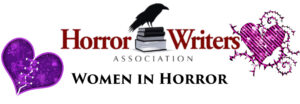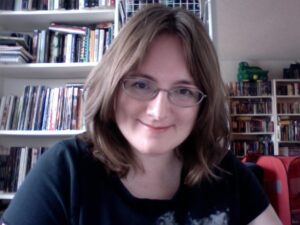Women in Horror: Interview with Gemma Files

 Formerly a film critic, journalist, screenwriter and teacher, Gemma Files has been an award-winning horror author since 1999. She has published for collections of short work, three collections of speculative poetry, a Weird Western trilogy, a story-cycle and a stand-alone novel (Experimental Film, which won the 2015 Shirley Jackson Award for Best Novel and the 2016 Sunburst Award for Best Adult Novel). Her collection In This Endlessness, Our End (Grimscribe) won the 2021 Bram Stoker Award for Superior Achievement in a Fiction Collection. This year she has two fiction collections coming out — Dark Is Better (Trepidatio) and Blood From The Air (Grimscribe).
Formerly a film critic, journalist, screenwriter and teacher, Gemma Files has been an award-winning horror author since 1999. She has published for collections of short work, three collections of speculative poetry, a Weird Western trilogy, a story-cycle and a stand-alone novel (Experimental Film, which won the 2015 Shirley Jackson Award for Best Novel and the 2016 Sunburst Award for Best Adult Novel). Her collection In This Endlessness, Our End (Grimscribe) won the 2021 Bram Stoker Award for Superior Achievement in a Fiction Collection. This year she has two fiction collections coming out — Dark Is Better (Trepidatio) and Blood From The Air (Grimscribe).
What inspired you to start writing?
I’ve always been an avid consumer and inhabitant of stories, but at a certain point I doubled down on it, becoming a storyteller, if only to myself. There was a formative moment during my childhood during which not wanting to be where I found myself became my default, so I taught myself to “daydream” my way out of my current reality. Part of it was boredom, but part of it was a combination of traumas—my parents getting divorced and my Dad moving back to Australia versus what I retroactively think must have been a subconscious understanding that there was something “wrong” with me, that other people definitely found me just as baffling and annoying as I found myself. In terms of a method of distraction, fiction was a lot better than self-harm.
What was it about the horror genre that drew you to it?
I’ve always had a lot of affinity for the darker side of things—Grimm’s fairy tales, decadent art, the mysterious and brutal sides of history, archaeology, mythology, witchcraft and black magic and true crime, the kind of poetry and music that gave me nightmares. My pattern always involved getting terrified by something, then getting fascinated with it: Analyzing it, breaking it down for parts, figuring out what components particularly attracted and/or repelled me. Slowly, a final stage developed, one in which I’d try to replicate and/or crossbreed these influences, creating something I could eventually call “mine.” I read fantasy (Tanith Lee, Michael Moorcock, Alan Garner) and horror (ghost and vampire stories, Stephen King, Peter Straub), searching for a place where I could see the two bleeding into each other (Cliver Barker, Neil Gaiman, Caitlín R. Kiernan); I took a long time to come to horror movies, because they were so immediate, so palpable, I could barely stand to commit myself to them. But weirdly, horror eventually struck me as the only way to talk about/use my own experiences that made any sense to me. Horror and poetry are two types of writing in which metaphor becomes reality. They’re like magic, in that way.
Do you make a conscious effort to include female characters and themes in your writing and if so, what do you want to portray?
For a long time, I thought I was “only” attracted to male characters, mainly because of the negative ways in which I saw “normal” female characters portrayed… I mean, I wanted female protagonists, but they needed to be ones I could identify with, and the transition from child-oriented fiction to adult fiction made that really hard. Then again, for every Harriet the Spy there were a thousand Susan Pevensies, backgrounded or written out—and even Harriet had to repent, be punished for her hubris, before she could be accepted socially and reach her supposed happy ending. Adult female characters seemed to exist within narratives simply to support men or throw roadblocks in front of them, to be acted upon, to be sacrificed for someone else’s heroic journey. I’ve also been very attracted to queer male characters pretty much ever since I first started having sexual feelings, which threw an additional spanner in the works. When I found a character I identified with, my first instinct was therefore to either keep them male but queer them or—increasingly—try to figure out who they’d be if they were mainly the same person, just female. To reframe them, and see what changed.
The first stage of this pattern gave rise to my Hexslinger Trilogy, though even by Book Two of that, I’d realized that my work really did seem like a massive bag of d*cks. So while I certainly continue to do both of these things on a personal level, a few years back I made a decision to mainly write characters who are female and/or non-default (not het, not cis, not white, etc.). I want these characters to be as active as possible, as difficult as possible and as full of the characteristics which most attracted Young Me as possible: Rage, hunger, sidelong magic, unrepentant monstrosity. I’m a firm proponent of monster pride, of being an Other rather than being Othered (or Othering). It’s probably the neuroatypicality speaking.
What has writing horror taught you about the world and yourself?
The biggest revelation writing horror gave me is that it’s not only okay to be myself, even when writing fiction…it’s actually essential. That’s probably why my best-reviewed novel thus far is Experimental Film, in which the main character is basically a version of myself (obsessive, depressive, a former film teacher, the probably-autistic mother of an autist son, etc.), and my best stories are built around as much of my own life-experiences as I can lard into them. (The Puppet Motel, for example—how’d you get that idea, Gemma? Well, first I managed two Airbnbs, one of which was superlatively creepy, like so creepy I thought, “Hm, what if it was haunted?”) I teach a course called Write What You Fear, usually once a year; summed up, its thesis is that subjectivity equals objectivity. In other words, the more specific your details and characterization, the wider an audience of people your fiction will attract. It’s funny because it’s true.
How have you seen the horror genre change over the years? And how do you think it will continue to evolve?
I started to sell during the mid-1990s, when horror was no longer mainstream—the horror boom of the 1980s was over, and things had to skew increasingly extreme, erotic or both, just to attract attention. I never thought my stuff was “enough” of either to qualify, but apparently it did, so that was nice. OTOH, being a woman who wrote horror (white, het[ish] and cis though I might be) was still kind of odd in itself, especially since I looked like a super-boring urban Torontonian with vague punk affectations. In the years since, I’ve been happy to see ever more women, more POC, more trans people, more queer and genderqueer people…more of everybody join the ranks. More global horror made available through translation. More revisionist rather than restorative narratives. More acknowledgement of trauma as strength rather than weakness. More broadening and deepening of what horror is, what it can be “allowed” to be. More understanding that horror isn’t the narrowest of genres, it’s the widest—the most integral. The one where all of us, storytellers and readers alike, eventually can’t help but meet.
How will it continue to evolve? I’m not sure, entirely. I think it will, though. I don’t think we’re going back, no matter how high conservative, nationalist and religious feeling rises world-wide. The pandemic will help with that, at least for a while—a generation. And then? We’ll have to see.
How do you feel women have been represented thus far in the genre and what hopes do you have for representation in the genre going forward?
There’s a phrase that goes around a lot in certain circles which claims that horror is the genre most likely to centre female characters, aside from romance. And while I definitely think that’s true, I think it’s mainly because of Final Girl Syndrome—said female characters tend to be threatened rather than threatening, younger rather than older, morally clear rather than morally grey. My own characters tend to be the opposite, and I’d love to see that reflected over the next ten years—more creeps, more crones, more narrators that are unreliable due to lying rather than mental illness. I’m going to do my part.
Who are some of your favourite female characters in horror?
Recently? Jade Daniels, from My Heart is a Chainsaw and Don’t Fear the Reaper (Stephen Graham Jones); Eunice Houghton, from The Spite House (Johnny Compton); Hetta Salter, from 8:59:29 (Polly Schattel); Maggie Caine, from The Bedeviled (Thomas Cullinan); Mia Thomasina, from Black Mouth (Ronald Malfi); Madeleine Lowe, The Hollows (Daniel Church). And then there’s always Merricat Blackwood, from We Have Always Lived in the Castle (Shirley Jackson), the queen of all unrepentantly unreliable narrators. So many, soooo many.
Who are some women who write horror you recommend our audience check out?
Lynda E. Rucker, Paula Ashe, Hailey Piper, Fiona Barnett, TC Parker, Ally Wilkes, Tracy Cross, Laurel Hightower, Kristi DeMeester, Wendy N. Wagner, A. C. Wise, Cynthia Pelayo, Silvia Moreno-Garcia, V. Castro, Elizabeth Hand.
What is one piece of advice you would give horror authors today?
Don’t think about what you shouldn’t write; think about what you WILL write.
And to the women who write horror out there who are just getting started, what advice would you give them?
Same. 🙂



